
Allocation plays a pivotal role within the realm of supply chain management, and its significance cannot be overstated. Many of our clients currently harness the capabilities of the Supply Allocation feature embedded in NetSuite; however, they often underutilize its full potential. This feature holds immense importance due to its capacity to address a multitude of challenges faced by our customers. These challenges encompass supplier lead times, surpluses of on-hand materials, limited visibility into inventory commitments, and the absence of cohesion among various inventory locations. Notably, the Supply Allocation feature bridges the gap not only between the timing of goods arrival but also the timing of their procurement. It empowers users with real-time allocation of supply orders to meet demand, offers flexibility through the utilization of multiple criteria for allocation prioritization, allows for distinct management of locations, items, and order types, and accommodates both automated and manual intervention. In essence, Supply Allocation delineates the connection between a supply order, a purchase order, or a work order, and their role in fulfilling demand, primarily in the form of sales orders.
What is Supply Allocation?
Supply Allocation strategically matches inventory supply sources to demand sources. This robust feature provides you with the capability to meet demand requirements accurately, ensuring the right product, quantity, and location are precisely synchronized within the specified timeframe. Furthermore, the Supply Allocation functionality expands its scope by incorporating upcoming inventory from supply orders into existing on-hand inventory, enhancing inventory commitment calculations.
NetSuite’s process of dedicating or reserving on hand or arriving inventory stock to outgoing orders. It replaces the standard item commitment (Available, Complete, Do Not Commit). This feature more accurately tells inventory manager if supply is going to be late or needs to be ordered. This also allows customer service to provide the customer with a more accurate estimated date of arrival.
NetSuite’s Supply Allocation Feature
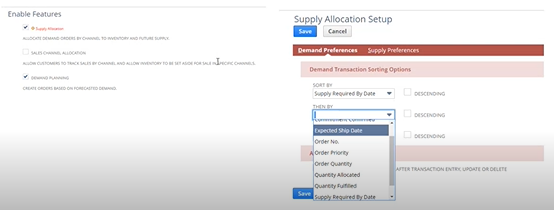
In Advanced Inventory management, enable the supply Allocation feature. This will create a new Setup option called Supply Allocation Setup that controls the overall settings of the feature. It starts by allowing you to sort or prioritize your orders. It is usually sorted by supply “required by date” which means a specific number of supply is needed by this date to meet the demand. Also referred to as expected receipt date. Supply required by date is really expected receipt date. You can sort by any of these filters.
Now that the Supply Allocation is set up, we can move on to the Order Allocation Strategy. In our experience with our clients, usually only one strategy is set up. When setting this up the most important thing is what constitutes something that can be allocated. On the left-hand side anything that is coming in as an inbound shipment, purchase order, transfer order or work order is something that can be allocated to a future inventory demand (sales order or work order). The Allocation method is simply saying if there are two orders that are available before needed to ship out, which order do you want to pick, an order that is going to arrive as close to the ship date or the earlier one.

Once this feature is enabled, below is what the order line will look like in NetSuite. The allocated supply box on the right replaces the commit dropdown that says available, do not commit or complete quantity. Once this feature is enabled, that will no longer show as an option. This feature shows the allocated supply for a specific sales order. When clicked on the ‘Allocated Supply’ the below screen will show the Customer Service representative insights on the allocated supply. It will show what’s dedicated, the purchase order, and when it will arrive. You can see the purchase order, set to arrive on March 15th, that supply is being allocated to that order. Once it arrives, that is the goods that will be shipped out.
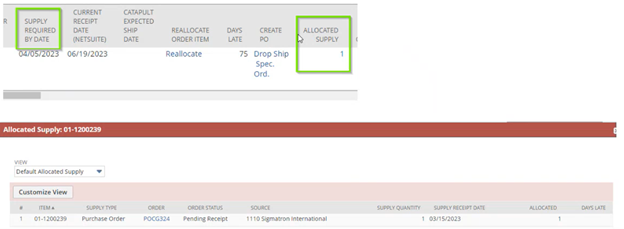
It also works the opposite way, on the Purchase order side. Once a Purchase Order is created, it allocates its demand. In the allocated demand, it will tell you when you receive the stock, what it will be allocated to. For example, the demand that it’s allocated to is Sales order 2296, it’s set to ship by April 5th which is good because my dock date is March 15th. The user can see what has been allocated and what is available.
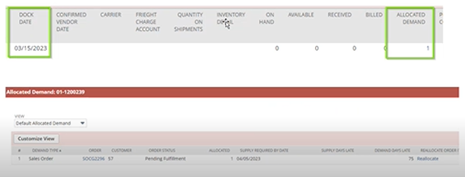
Running Allocations on a Schedule
You can manage this yourself by making manual allocations or setting it on a schedule. If you are familiar with billing operations in NetSuite, it’s a very similar concept. You can build criteria that state specific orders that you would like to allocate. For example, one of our clients has an allocation schedule that runs daily. Any orders entered the day before run through the allocation metric. The reason is they have different priorities. Even though something may be committed that day on a future order, they get a new order the same day, they want the system to reallocate that supply because they want their orders to go out by closest ship date.
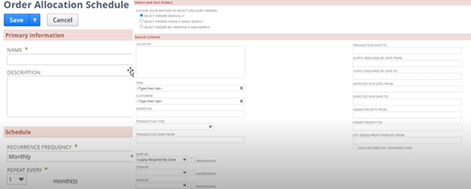
Reallocate Manually
This allows a purchasing manager to go in and reallocate themselves, manually. You will use this feature in unique situations. You can move your allocations across. Once this is reallocated, it will show you which orders are missing in allocation, and you can cut a purchase order.
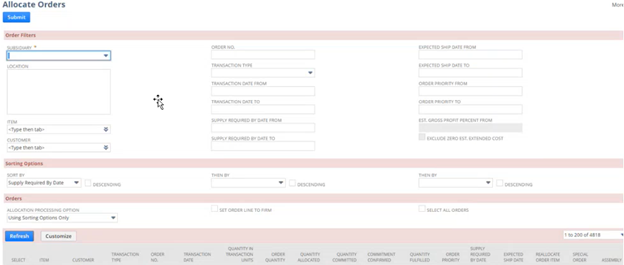
With NetSuite Supply Allocation, companies gain the ability to set preferences and customize their preferred inventory allocation method. Whether your priority is adhering to a first-in/first-out allocation system or aligning orders based on sales channels, this system accommodates all your needs.
![]()
Keystone. Your NetSuite solution provider and integration partner.
Call – 866-546-7227 | Email – info@kbscloud.net
 About Stacy Okyne
About Stacy Okyne
Stacy has over 15 years’ experience in the Marketing Profession. She brings experience in an array of industries including advertising, education, production, hospitality, and technology. She has a good grasp and understanding of consumer insights and needs. Strategic thinking and leadership skills are among her qualities.
Stacy was born in Monroe, Michigan and moved to the Northwest suburbs of Chicago at an early age. She was raised in the Northwest suburbs of Chicagoland and currently resides in Naperville with her husband, three children and two dogs. Stacy graduated from Illinois State University – Normal, Illinois with a Bachelor of Science in Marketing. In her spare time, you can find her watching her three children participate in sports including basketball, football, and Track & Field. She is a DIY’er at heart and shopping is one of her favorite activities.





